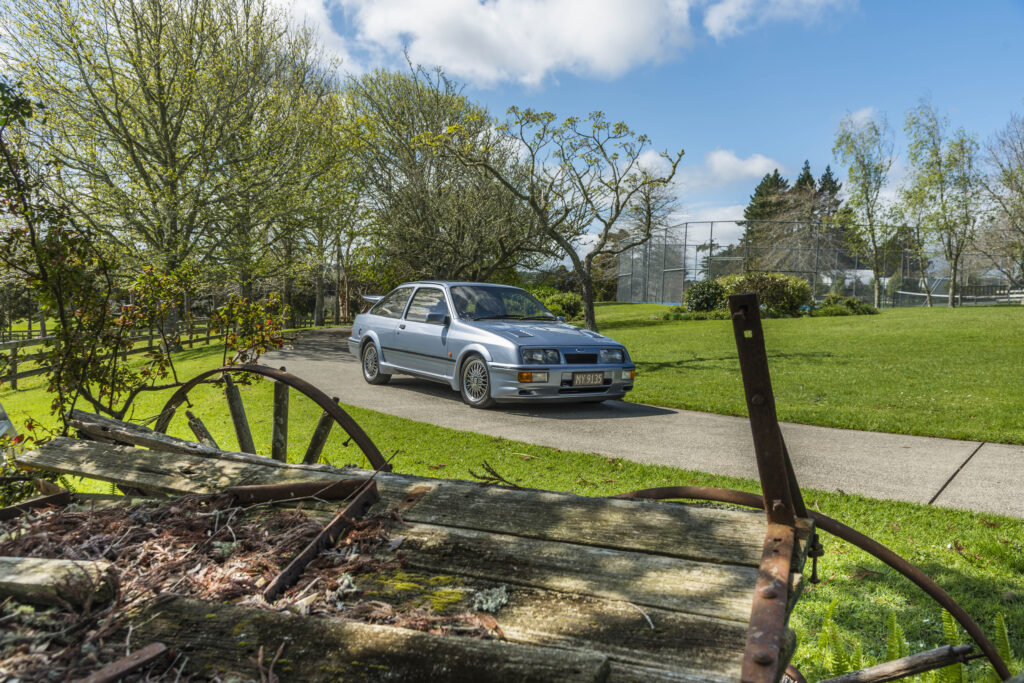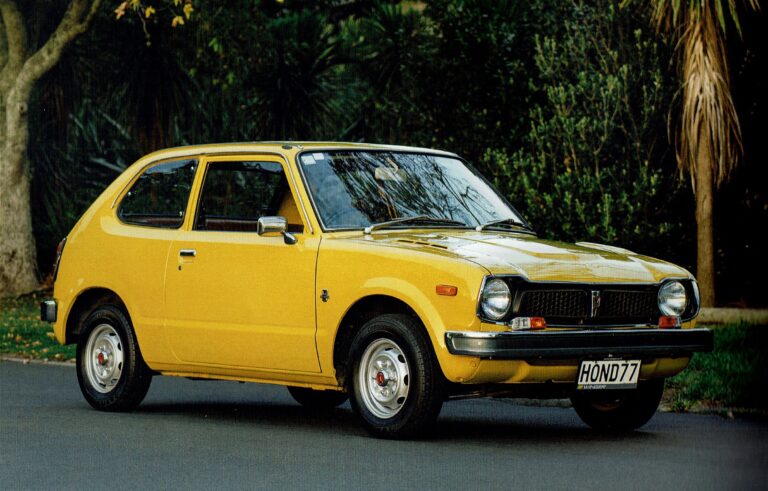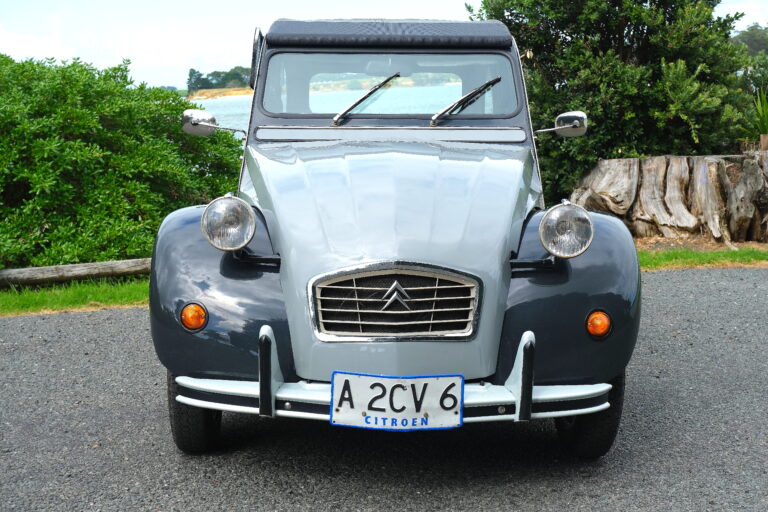The name conjures an instant sense of respect for one of the cars that helped define an era of sport saloon racing. It gave Ford fans something to smile about then — and now
By Ian Parkes
Photography: High Art Photography
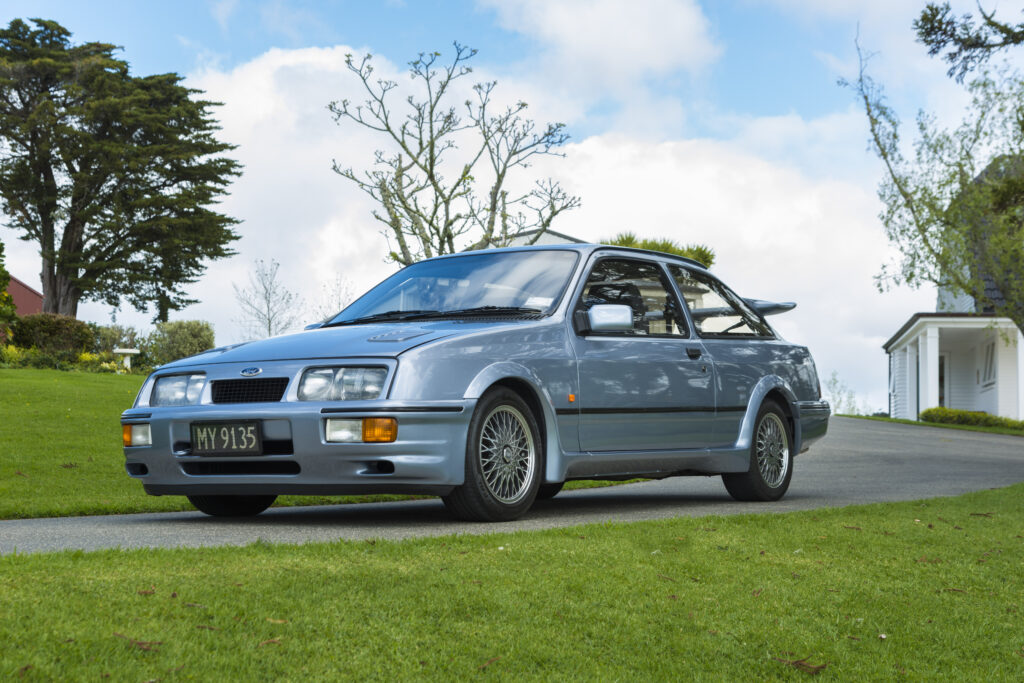
For most car-conscious folk of a certain age the sight of a whale tail still has its own magic.
No mere spoilers, these excessive peacock-fan displays signal a car with too much power to be held on the road by the weak fundamental force of gravity. Porsche 930 turbos needed them to correct the wrong-headedness of having all that power thrusting from behind the rear wheels and Sierra Cosworths also needed them for genuine road-holding reasons.
When Ford launched the bravely rounded Sierra in 1982 to replace the boxy Cortina, its blobby shape and expressionless face wasn’t universally loved. It was most-often likened to a jelly mould. It was fundamentally a better, more modern car than the Cortina but run-out deals on the Cortina kept sales low in the UK. It sold well from the outset in Germany, and in the following year, 1983, UK sales picked up and it finished second only to the Escort. Its more modern shape held it in good stead against less characterful rivals in later years — although when Peugeot launched the beautiful 405 in 1987 you had to wonder why other makers and designers were so keen on unlovely shapes.
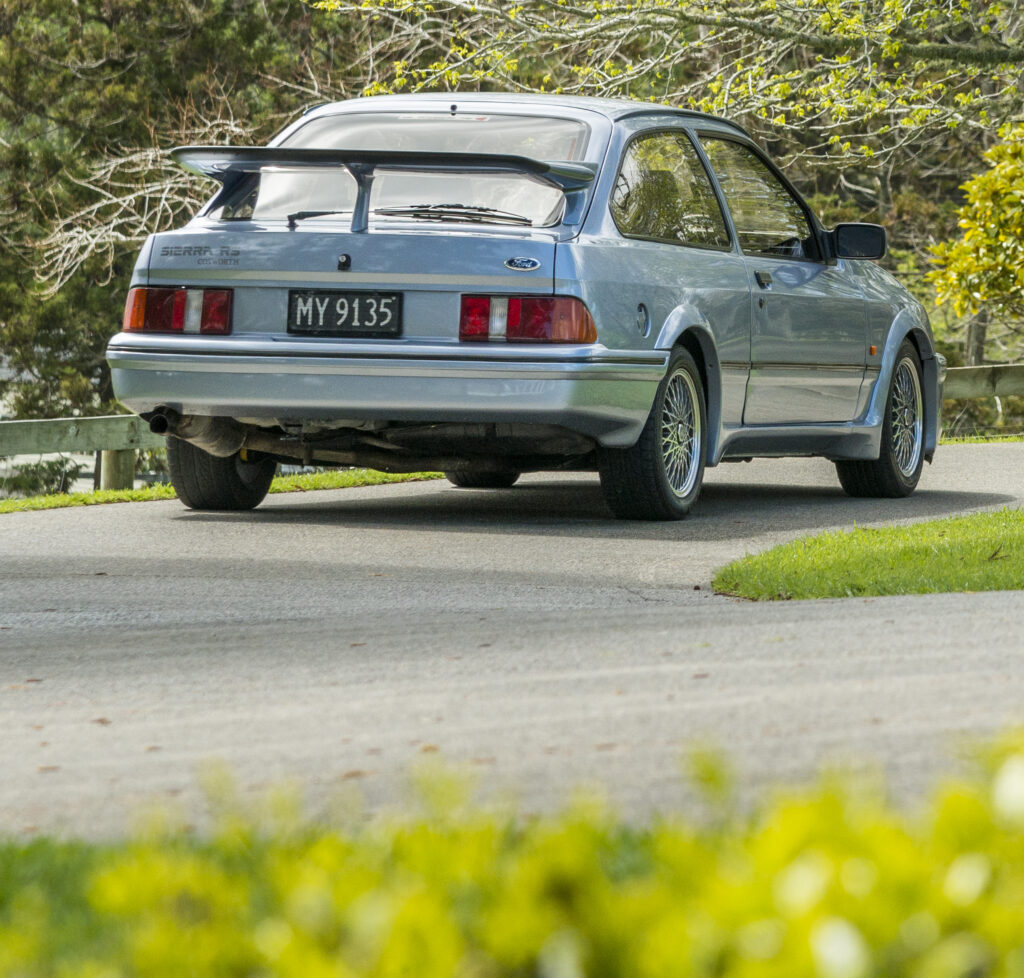
Growing into its looks
What’s curious about looking at the Sierra Cosworth in the flesh now is how square the car looks and how well the blend of lines and curves works. It looks more sophisticated now than it did when it was new. Then there’s that tail. You can’t help but smile.
It was completely necessary. The car might have been a wind-tunnel hero, scoring a drag coefficient Cd — whatever that is — of 0.34, compared with the outgoing Cortina’s 0.45, but it was unstable. Drivers complained about the car wandering in crosswinds. In 1985, Ford added little strakes to the trailing edge of the rear side glass.
When Ford decided to go racing with the rear-wheel drive Sierra this became a real issue. Engineer Lothar Pinske took command of the bodywork, insisting on complete control if he were to get the car to stay on the ground at 300 kph. After extensive wind-tunnel testing the car emerged with its outrageous tail, as well as wheel arch extensions and an opening in the grille — a plus on the looks front — to feed the intercooler.
Nowadays, it looks the shiz but, at the time, it made Ford nervous. Stuart Turner, the head of Ford Motorsport who had initiated the project, had signed up to a deal with Cosworth, which had developed a potent 16-valve twin cam engine based on Ford’s Pinto block. Ford commissioned a turbocharged version knowing it would have to homologate the car. The baseline for Group A homologation was 5000 cars. However, Cosworth said Ford would have to take 15,000 engines and they would have over 200 horsepower rather than the 188 Ford was working around.
It’ll never sell
When Ford showed the car to dealers, even those who had seen Cortina and Escort GTs and Mexicos fly out the door thought the tricked-out Sierra, and especially its wing, was over the top. They predicted they would sell only 1500 of them. It’s a credit to Turner and his team that they pressed on with the project and the car launched in 1986. They took some radical decisions to make it work, offering the car in only three colours: black, white, and the Moonstone Blue we have here. Apart from the Recaro seats they all got the same Ghia-spec interior, with only two levels of trim. It came with, or without, central locking and electric windows. That’s also why there are four-door Sierra Cosworths; Ford had to use the other 10,000 engines.
Before we go on we must acknowledge this is not one of the more-famous RS500 Cosworths, developed by Aston Martin Tickford and homologated in 1987, when only 500 road-going versions were required for homologation. Hence the name.
Five hundred three-door bodies were dedicated to the project. Among other things, they were furnished with a bigger turbo and intercooler, reworked induction, oil and cooling systems, and twin rail injectors — only one bank was activated in road cars.
The competition engine was allowed to soar from 350 to 550bhp but the road-going 500s only saw an increase from 201bhp (or 204 depending on the source) to 220bhp. Externally, they are distinguished by badges and, most obviously, a second wing on the boot lid as well as additional vents on the front air dam that replace the fog lights — oh, and by their price. Expect to pay close to $250,000 for a showroom-condition one.
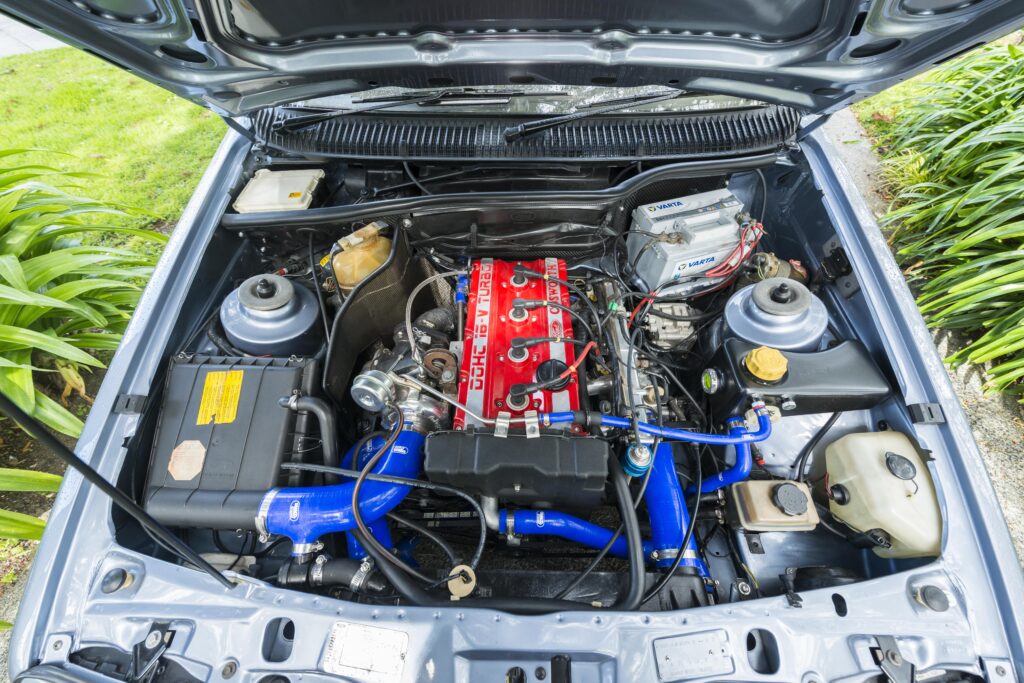
Racing record
These cars were phenomenally successful in racing. In 1987 the RS500 won pole World Touring Car Championship events, and took the chequered flag in four. The works Eggenberger Motorsport cars were disqualified from the 1987 Bathurst 1000 for wheel arch panel irregularities but the team won the 1989 24 Hours of Spa. Another team won the 1990 British Touring Car Championship in a RS500. Dick Johnson and John Bowe stormed to first and second in Sierra Cosworths in both the 1988 and 1989 Australian Touring Car Championship. The RS500 won the Bathurst 1000 in 1988 with Tony Longhurst and Tomas Mezera and in 1989 with Johnson and Bowe. Allan Moffat and Gregg Hansford also won the 1988 Sandown 500 in one. Robbie Francevic won the New Zealand Touring Car Championship twice in an RS500, in 1989 and 1990.
Buyers could, and frequently did, buy all the bits to build the road-going cars up to RS500 spec but if you were content with a standard-spec RS500, the only marginally less powerful standard Cossie was much better value.
Apparently 5545 all-told were built, all in Ford’s Genk, Belgium factory. A handful came to New Zealand, either as dealer or private imports. Remarkably, only one was imported officially by Ford New Zealand.
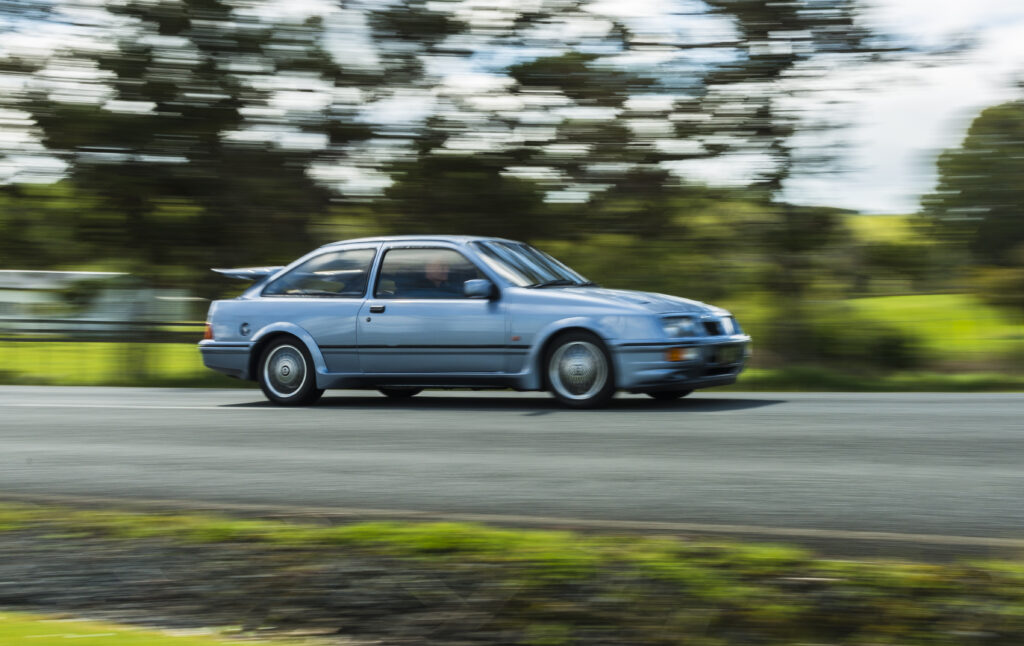
Provenance provided
The dealer principal at South Auckland Motors at the time, Garry Jackson, says the car was used as part of a big ‘Fondle a Ford’ promotion and to promote the launch of the new Manukau city dealership. He takes up the story.
“It was the only Cosworth directly imported by Ford New Zealand. I used all my associations and connections to convince Ford to do it, based on the importance of the launch of the new dealership. Working directly back there from 1990, I’m sure there were no other direct imports. All other Cosworths in New Zealand were imported either as tourist delivery imports by dealers in the name of private individuals — Central Ford in Taupo was active in this area, importing three or four — or as used cars.
“I kept the car under tight control — all such demos were strictly controlled, I don’t remember the car ever being lent to anyone unsupervised. Apart from a brief drive around the block, I didn’t even drive it myself — despite the temptation for an evening run to our then home in Maraetai Beach!”
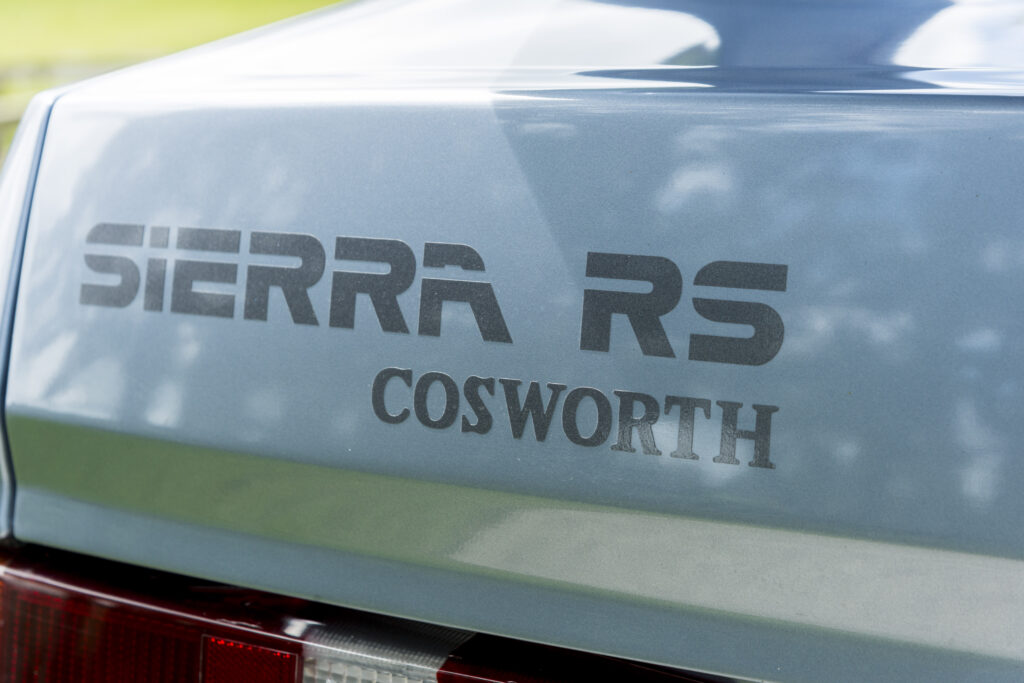
Family rocketship
The car was snapped up by half of the Marshall/McWatt rally team that dominated the scene in the late ’70s. Jackson says Mike Marshall’s co-driver and navigator Arthur McWatt bought it during that Labour weekend promotion.
It was Arthur McWatt’s personal car for the next five years. He died in 1992, but his wife Ruth says, “It was quite a thing when we drove it out of the showroom!”
Arthur didn’t put a lot of miles on it as he had a work vehicle from his aluminium windows factory franchise business. Ruth had her own Sierra XR4i but the couple used the Cosworth for longer trips.
“We sure did!” she says. “We often went down to the Wellington street races with a friend who also had a Cosworth. Some of those trips were very quick.” Arthur managed to run up nearly a full card of demerit points.
Ruth says she rarely drove the car as it wasn’t much of a town car.
“It was Arthur’s car,” she comments.
She decided to sell it in 1993. It was spotted at a Panmure Ford car yard by, in essence, only its second owner, Brett Houston.
Brett has always been something of a Ford man. His first car was an Anglia so, in the usual way, the die was cast. He still has an Anglia, a Mk2 Escort, and a Mk1 Consul in his shed and he fairly quickly decided he should have this car. It wasn’t cheap — even in the early ’90s — but Brett understood Sierra Cosworths were already acquiring the respect due to a true classic.
“I really enjoyed driving it,” says Brett.
He used the car regularly until it failed a warrant for some unseen rust in the inner guards. Even the cars that are not in tweaked race tune need disciplined servicing as the design was pushed for its performance goals. There’s quite a lot that can go wrong with some of the early generation technologies used.
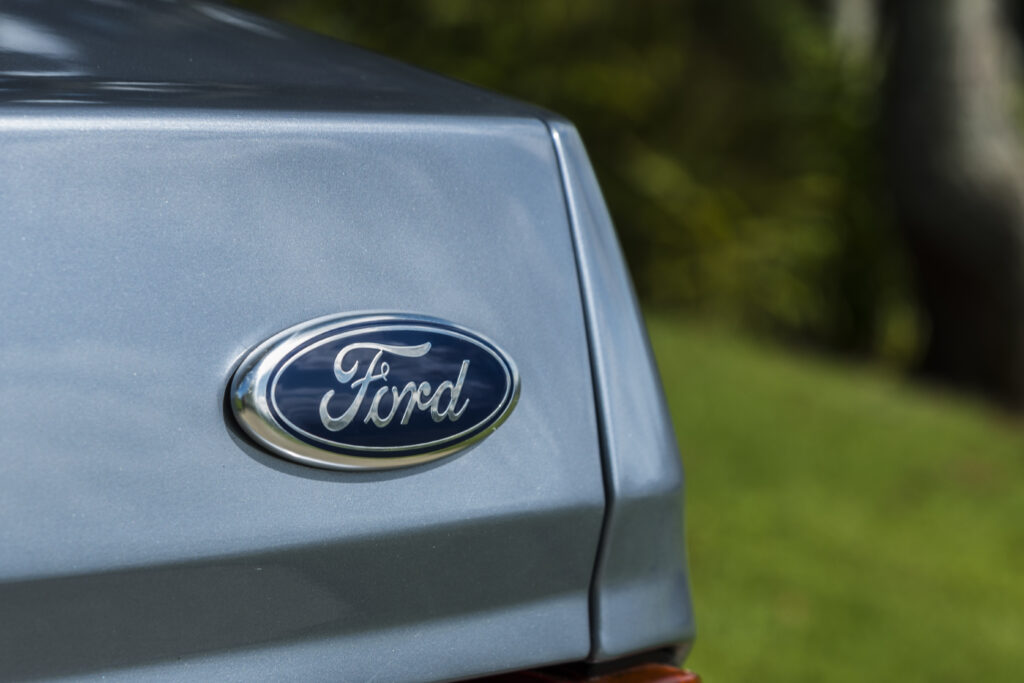
High maintenance
The cam belt needs changing every 50,000km or three years. Misfires, apparently common, can be caused by the good old rotor arm, distributor cap, leads, and plugs. They all need to be in good order. The engines suffered from internal corrosion leading to head gasket failure. Fans need to be in tip-top order. Any air leaks in the turbo system or the fuel rail systems can have expensive consequences. A poor fuel supply can make the engine run lean and melt the pistons.
Brett knew this was really the time to do a comprehensive rebuild but, as is the way of these things, the car sat in his garage for a while before he decided he had to crack on with it.
The engine and dashboard had to come out and all ancillaries removed to allow welding in the engine bay, so Brett enlisted the help of a friend, Ken Grant, to strip the car completely. Silverdale Panelbeaters did the welding and re-building of the inner guards. It was repainted by Wilson Fletcher spray painters in Wainui. The car went back into the shed where Brett, with help from some skilled friends reassembled it. He says he took the opportunity to replace all parts that could be replaced whether they needed it or not.
The result is a pristine and taut example of the first generation Cosworth with 188,000 miles on the clock that seems to have stepped right out of the 1980s. A walk around the car offers a number of period delights besides that glorious wing. The Cosworth sticker is plain and simple. The arch extensions and daily modestly-sized wheels are much more purposeful than showy. The Recaro seats looks the business, and they are, but when you sit in it and survey the dash the impression is that it is far from special. Only the RS badge set into the passenger’s side of the dash and a small turbo-boost gauge on the instrument panel suggest this is not your average Sierra. Perhaps the door trim in the same cloth as the seats is Cosworth only.
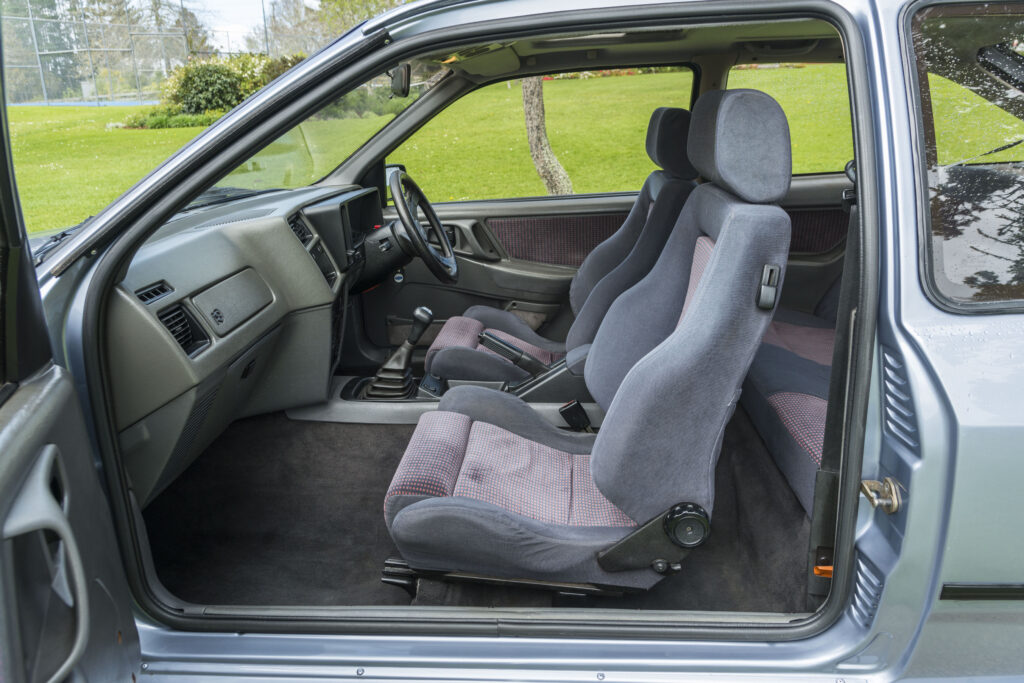
Tricks of the trade
The dashboard itself is an unappealing shade of grey, different from the doors. You might prefer black. Too bad. All of them, even the black cars, had this same grey interior. Brett keeps a period shine on it by following some advice given long ago, to use only baby oil on vinyl interiors. The overall effect is a clear reminder that you are in a car from a previous era, and that makes it special enough.
Starting the car and manoeuvring it out of the driveway is simplicity itself. At this point the car feels modern enough. I take care traversing the driveway to the road and set off down the hill, quickly feeling at home. It is easy to drive. The clutch is light, the gearbox is compliant, and the steering is a little weightier than modern cars but I prefer that anyway.
The engine sounds like a typical four, breathing through a slightly more open than standard exhaust and at this stage, while it warms up, it feels like one. Despite all the plastic, the car is free of squeaks and rattles — which isn’t authentically period. The suspension is firm but not harsh.
As the engine comes up to temperature I use a few more revs. The exhaust gets louder and you can feel the turbo getting down to business, a pleasure that more modern cars have engineered out of the equation. In this mode the car soon puts a smile on your face and it’s easy to see why Brett is so fond of being behind the wheel. It is not frighteningly fast by modern saloon standards, but full noise 0-100km of less than seven seconds is still respectable, and it is certainly fun. You can feel, through the seat of your pants, that those people at Ford wanted to create a weapon on the track. Even if the shape gave them problems, it provides another reminder to the casual Cosworth driver of that serious intent. A simple glance in the rear-view mirror shows the view bisected by that huge wing. Cue another big smile.
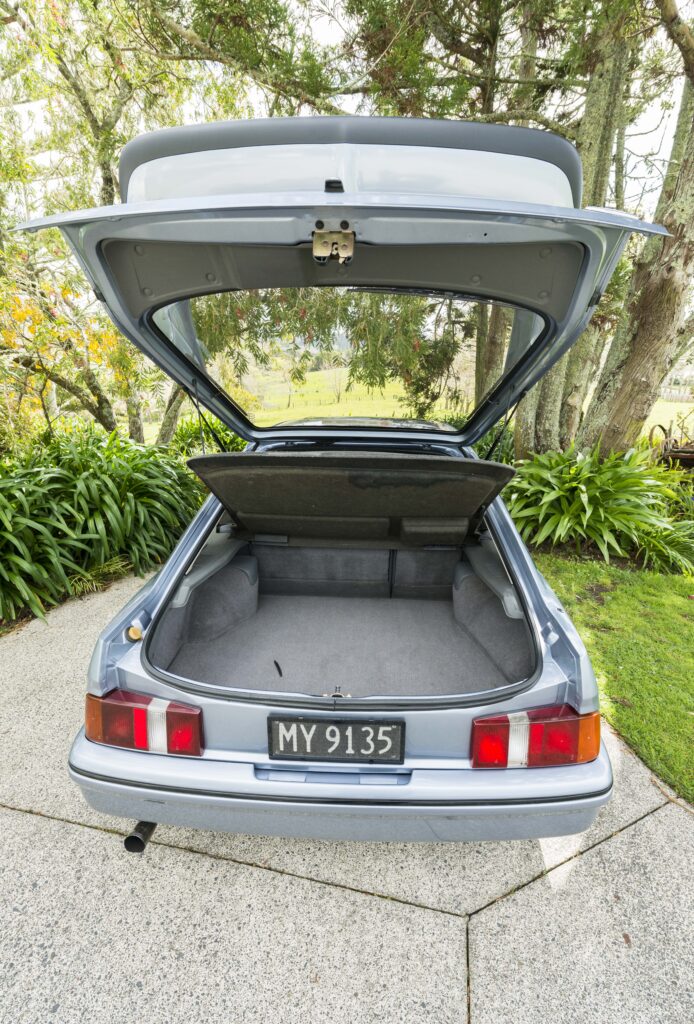
Full circle
This car is a very appealing modern classic. You know some very clever people at Ford and Cosworth worked at every angle allowable under the fairly strict Group A rules until they turned this rep-mobile into a performance car. It fully lived up to their hopes and aspirations on the track, yet the road car version is surprisingly easy to live with.
Yes, Mrs McWatt, I agree it’s not really a town car — mainly because you want to make the most of its hugely flexible engine on roads where you can really stretch its legs, as Arthur used to do.
Brett finished the rebuild in 2019 and felt he had honoured its history, so got in touch with Ruth McWatt to see if she would like to see it again.
“She was very keen,” he says. “I think she is as enthusiastic about the car as I am.”
Brett drove it around to see her and her daughter, who also remembered the car well. It was a reunion everyone enjoyed.
There was one other person Brett thought should see the car again. For a time Brett worked on a project that involved Arthur’s racing partner, Mike Marshall. Brett asked him if he wanted to pop down to the garage and maybe take it for a spin?
“He drove it up Auckland’s Symonds St — at sub-racing speeds — but it was still a nice moment,” Brett says.
Two Ford legends, right there.
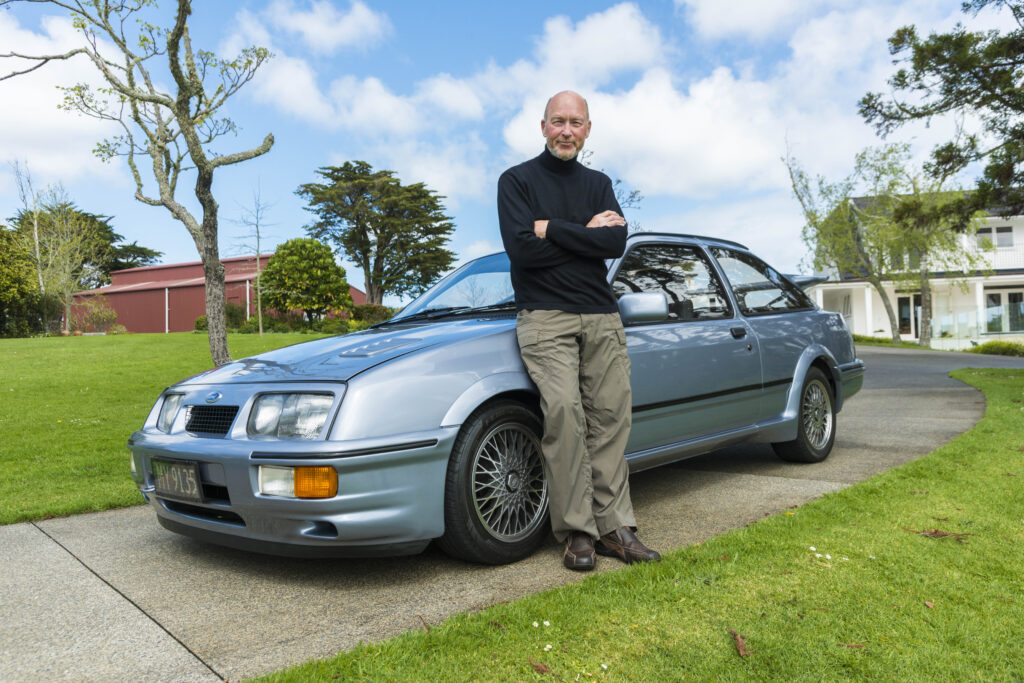
1986 Ford Sierra RS Cosworth specifications
Engine: Straight-four, 1993cc, DOHC 16-valve
Bore x stroke: 90.8mm x 76.95mm
Aspiration: Garrett T3 turbocharger with intercooler
Compression ratio: 8:1
Gearbox: Five-speed manual
Power: 201bhp, 150kW @6000rpm
Torque: 277Nm @4500rpm
Steering: Power-assisted rack and pinion
Suspension F: MacPherson struts, lower control arms, coil springs, anti-roll bar
Suspension R: Semi-trailing arms, coil springs, anti-roll bar
Brakes F/R: 283mm vented disc/273mm solid disc
Tyres: 205/50VR15
Length: 4425mm
Height: 1420mm
Wheelbase: 2608mm
Track: F/R 1452/1468mm
Kerb weight: 1220kg
Acceleration: 0–100kph 6.8secs
Standing quarter-mile: 15.5s
Maximum speed: 230kph
